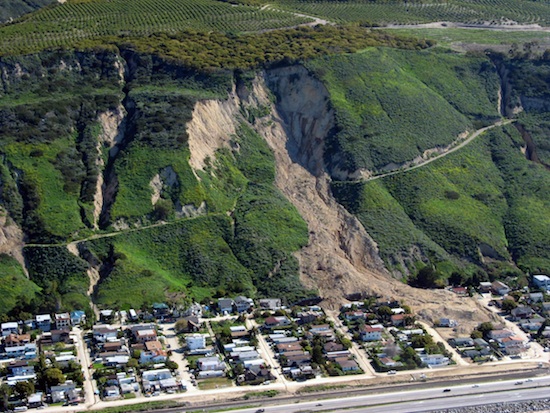|
Weathering, Erosion, and Mass Movement Mass MovementMass movement is the down slope movement of earth materials under the influence of gravity. The detachment and movement of earth materials occurs if the stress imposed is greater than the strength of the material to hold it in place. Shear strength is a measure if the resistance of earth materials to be moved. The interlocking of soil particles increases the ability of material to stay in place. Plant roots also help bind soil particles together. Shear stress is primarily a function of the force exerted by the weight of the material under the influence of gravity acting in the down slope direction. The slope of the surface determines the amount of stress that occurs on earth materials. Water destabilizes hill slopes by creating pressure in the pore spaces of earth materials. Water infiltrating into slope materials saturates the soil particles at depth by filling the pore spaces between. The weight of water lying above creates water pressure that drives soil particles apart. This lessens the friction between them and enables them to slip past one another. Material is mobilized when the shear stress imposed on a surface exceeds the shear strength. The movement, especially in the case of slides and slumps, is along a failure plane. The failure plane may be a well-defined layer of clay or rock upon which sets the destabilized surface material. Humans induce mass movement when subjecting a slope to a load that exceeds its ability to resist movement. People building houses on scenic hill slopes often find their homes threatened by a landslide. Undercutting of hillsides during road construction commonly creates unstable slopes making them prone to failure. Types of mass movementSoil creep is nearly imperceptible to the naked eye as it is the slowest of all types of mass movement. Soil creep generally occurs in the top few meters of the surface and is accomplished by expansion and contraction of the soil. For instance, when water in the soil freezes the ice pushes soil particles outward perpendicular to the slope. Upon warming, the ice melts and the soil is pulled down slope under the influence of gravity. Over many freeze-thaw cycles soil moves slowly down slope. In many cases one might not be able to tell that soil creep is occurring by just examining the surface. However, trees growing on surfaces undergoing creep will have curved trunks or roots that are curved. Broken retaining walls and curved railroad tracks also indicate creep in action. A slide is a sheet of material that slips over a failure plane ending anywhere from a meter to a kilometer down slope. Slides produce concave scars while slumps tend to produce a scarp or cliff exposure. Trees are broken and bent and the slide can bury the soil down slope. Digging into buried soils and analyzing their contents can tell us about the age and what the environment was like when the slide occurred.
Figure 17.9 La Conchita, CA 2005 landslide La Conchita, California has experienced devastating landslides in recent years. Unstable slopes mobilized by rain water caused a landslide and debris flow seen in Figure 17.9. The city lies on a narrow strip of coast 250m (800ft) wide between the shoreline and a 180 m (600ft) bluff above it. Extraordinary rains and rising groundwater levels caused the slope to fail, fortunately no one was killed. However, in 2005, another year of abnormally high rain fall caused the slope to fail again, this time burying structures and killing 10 people.
Video: "Landslides"
|

